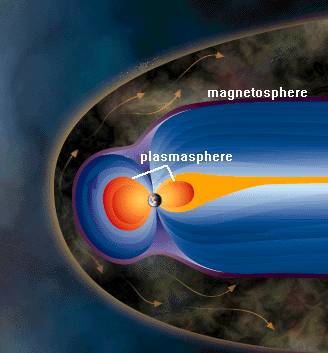
How the Plasmasphere is Formed
The Sun's ultraviolet light ionizes the upper part of Earth's atmosphere- giving ions high energy and creating plasma. The movement of this plasma is guided by Earth's magnetic fields. It builds up around Earth until there is a balance of pressure from below in Earth's atmosphere and from above where plasma densities rise from tens to thousands cm^3.
However, remember that at the same time, Earth is also rotating. Earth's movement affects the plasma's movement. Close to Earth, the plasma movement follows Earth's encircling drift paths, nearly rotating with it. As distance from Earth increases, these drift paths no longer circle Earth. Instead, they point towards the Sun.
These regions of Sunward drifting plasma cannot accumulate cold plasma from the ionosphere for long, so the densities reached are not as high as those closer to the Earth. There are two kinds of plasma drift paths- the Earthward drift paths and the Sunward drift paths. The boundary between these two types of plasma drift paths varies. The boundary is closer to Earth during stormy space weather conditions. It is further away during quiet times.
The main body of the plasmasphere is a donut-like region encircling the Earth where ionospheric plasma accumulates to high denisities over 24+ hours. Plasma can also accumulate to high densities further out, depending on space weather conditions. Regions that have ionispheric filling densities for more than 24 hours are considered to be regions of plasmaspheric plasma.
Web Links
NOAA's Space Weather Prediction Center - Today's Space Weather Updated Every 5-minutes
National Space Weather Program - The U.S. Government and Space Weather
Author: Dr. D.L. Gallagher dennis.gallagher @ nasa.gov
Responsible Official: Dr. David McKenzie
Last Updated: May 27, 2015
Responsible Official: Dr. David McKenzie
Last Updated: May 27, 2015
